Assessment 1: Analysis of Corporation Act Financial Reporting Rules
VerifiedAdded on 2020/07/22
|11
|3251
|324
Report
AI Summary
This report provides an overview of the financial reporting requirements under the Australian Corporation Act. It begins by defining and differentiating various company types, including large and small proprietary companies (both foreign-controlled and not), grandfathered large proprietary companies, listed and unlisted public companies, public companies limited by guarantee, registered schemes, unlisted disclosing entities, and wholly-owned subsidiaries with ASIC relief. The report details the specific financial reporting obligations, including the preparation of financial statements, directors' reports, and the need for audits, as well as the relevant sections of the Act. The report then covers the deadlines for submitting reports to ASIC and the requirements for communicating these reports to company members. It also explores the key steps required to ensure strong communication within the company regarding these reports. The report concludes by discussing the problems and their impact on the company's ability to produce reports.

ASSESSMENT 1 CORPORATION ACT
Paraphrase This Document
Need a fresh take? Get an instant paraphrase of this document with our AI Paraphraser
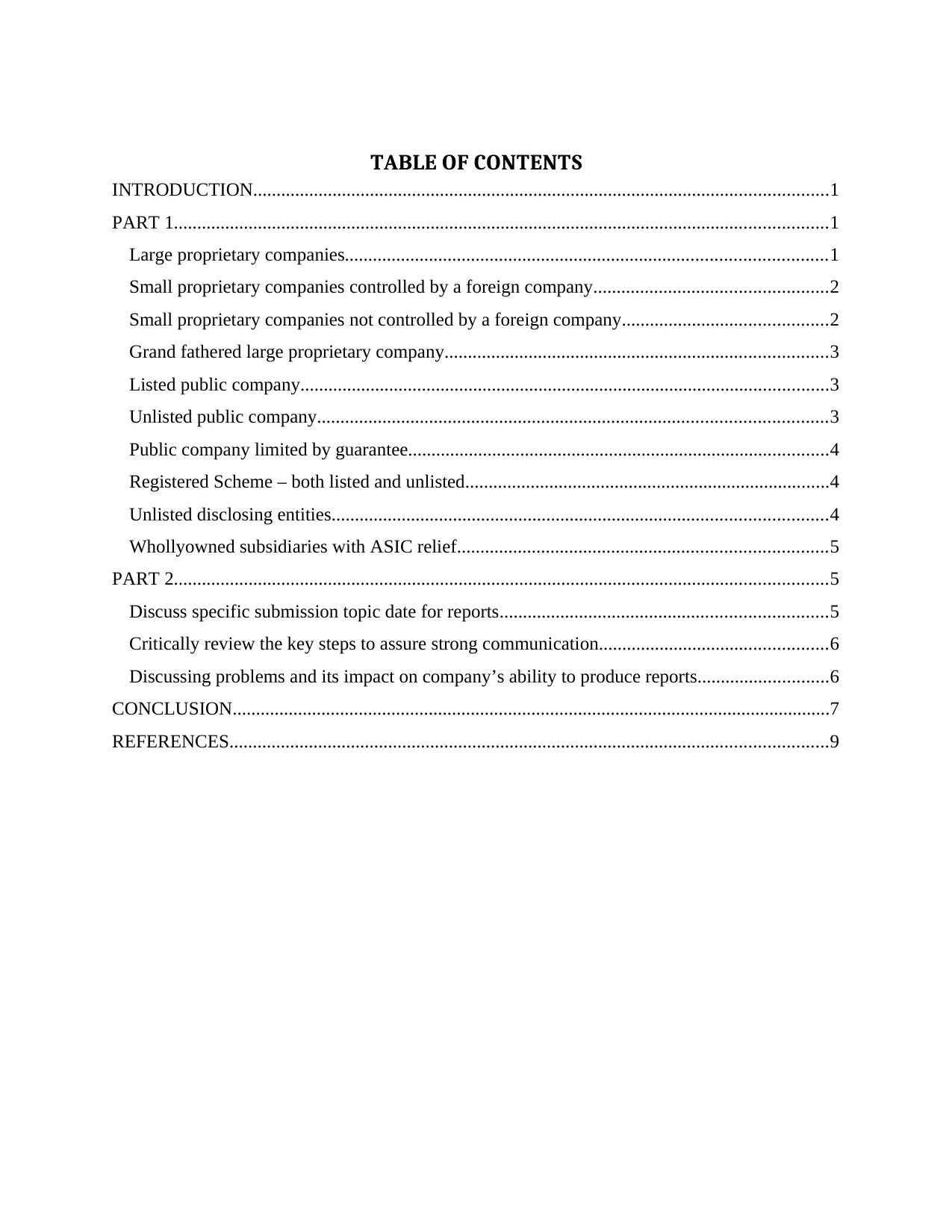
TABLE OF CONTENTS
INTRODUCTION...........................................................................................................................1
PART 1............................................................................................................................................1
Large proprietary companies.......................................................................................................1
Small proprietary companies controlled by a foreign company..................................................2
Small proprietary companies not controlled by a foreign company............................................2
Grand fathered large proprietary company..................................................................................3
Listed public company.................................................................................................................3
Unlisted public company.............................................................................................................3
Public company limited by guarantee..........................................................................................4
Registered Scheme – both listed and unlisted..............................................................................4
Unlisted disclosing entities..........................................................................................................4
Whollyowned subsidiaries with ASIC relief...............................................................................5
PART 2............................................................................................................................................5
Discuss specific submission topic date for reports......................................................................5
Critically review the key steps to assure strong communication.................................................6
Discussing problems and its impact on company’s ability to produce reports............................6
CONCLUSION................................................................................................................................7
REFERENCES................................................................................................................................9
INTRODUCTION...........................................................................................................................1
PART 1............................................................................................................................................1
Large proprietary companies.......................................................................................................1
Small proprietary companies controlled by a foreign company..................................................2
Small proprietary companies not controlled by a foreign company............................................2
Grand fathered large proprietary company..................................................................................3
Listed public company.................................................................................................................3
Unlisted public company.............................................................................................................3
Public company limited by guarantee..........................................................................................4
Registered Scheme – both listed and unlisted..............................................................................4
Unlisted disclosing entities..........................................................................................................4
Whollyowned subsidiaries with ASIC relief...............................................................................5
PART 2............................................................................................................................................5
Discuss specific submission topic date for reports......................................................................5
Critically review the key steps to assure strong communication.................................................6
Discussing problems and its impact on company’s ability to produce reports............................6
CONCLUSION................................................................................................................................7
REFERENCES................................................................................................................................9

INTRODUCTION
Australian corporate law is mainly derived from UK company law, ASIC (Australian
Securities and Investments Commission) is the regulatory or administration authority of
corporate law. The legislation sets out legal rules and regulations that companies working in
Australia either at Federal & Interstate level need to comply while carrying out their activities
and functions. The research concentrates on examining financial reporting requirements of
different companies. Later part emphasizes on analyzing the planning requirements when
completing such reports to lodge to ASIC.
PART 1
Australian Corporation Act governs and administers the conduct of business entities.
Section 45A of the CA, 2001 defined proprietary companies as a company that is a registered
firm under sec. 118 or 601BD of the act or converts to a proprietary firm under part 2B of the
Corporation Act. Such companies may be limited or unlimited company with having a share
capital and cannot employs above 50 non-employee shareholders. Section 292 of the Act
requires all disclosing entities, public companies, large proprietary firms that are undisclosed,
companies limited by guarantee and all small foreign-controlled proprietary companies to
prepare their financial reports (Baxt, 2016). It must be prepared with the compliance of
Australian accounting standards under s296.
Large proprietary companies
Section 45A subsection 3 of the act contains definition of large proprietary company. as
per the provision, if a proprietary firm meets out at least 2 or all of the below mentioned
conditions, then, it would be known as large proprietary company.
The revenue of the company and its controllable business entities is equals to or above
$25 million or other amount that prescribed under section 45A (2)(a) by the government
for such purpose (Halabi, Barrett and Dyt, 2010).
At the end of financial year, consolidated gross asset of the company and the other
entities that are under the business control equals to or more than $12.5 million or an
amount that is specified under 45A (2)(b).
1
Australian corporate law is mainly derived from UK company law, ASIC (Australian
Securities and Investments Commission) is the regulatory or administration authority of
corporate law. The legislation sets out legal rules and regulations that companies working in
Australia either at Federal & Interstate level need to comply while carrying out their activities
and functions. The research concentrates on examining financial reporting requirements of
different companies. Later part emphasizes on analyzing the planning requirements when
completing such reports to lodge to ASIC.
PART 1
Australian Corporation Act governs and administers the conduct of business entities.
Section 45A of the CA, 2001 defined proprietary companies as a company that is a registered
firm under sec. 118 or 601BD of the act or converts to a proprietary firm under part 2B of the
Corporation Act. Such companies may be limited or unlimited company with having a share
capital and cannot employs above 50 non-employee shareholders. Section 292 of the Act
requires all disclosing entities, public companies, large proprietary firms that are undisclosed,
companies limited by guarantee and all small foreign-controlled proprietary companies to
prepare their financial reports (Baxt, 2016). It must be prepared with the compliance of
Australian accounting standards under s296.
Large proprietary companies
Section 45A subsection 3 of the act contains definition of large proprietary company. as
per the provision, if a proprietary firm meets out at least 2 or all of the below mentioned
conditions, then, it would be known as large proprietary company.
The revenue of the company and its controllable business entities is equals to or above
$25 million or other amount that prescribed under section 45A (2)(a) by the government
for such purpose (Halabi, Barrett and Dyt, 2010).
At the end of financial year, consolidated gross asset of the company and the other
entities that are under the business control equals to or more than $12.5 million or an
amount that is specified under 45A (2)(b).
1
⊘ This is a preview!⊘
Do you want full access?
Subscribe today to unlock all pages.

Trusted by 1+ million students worldwide
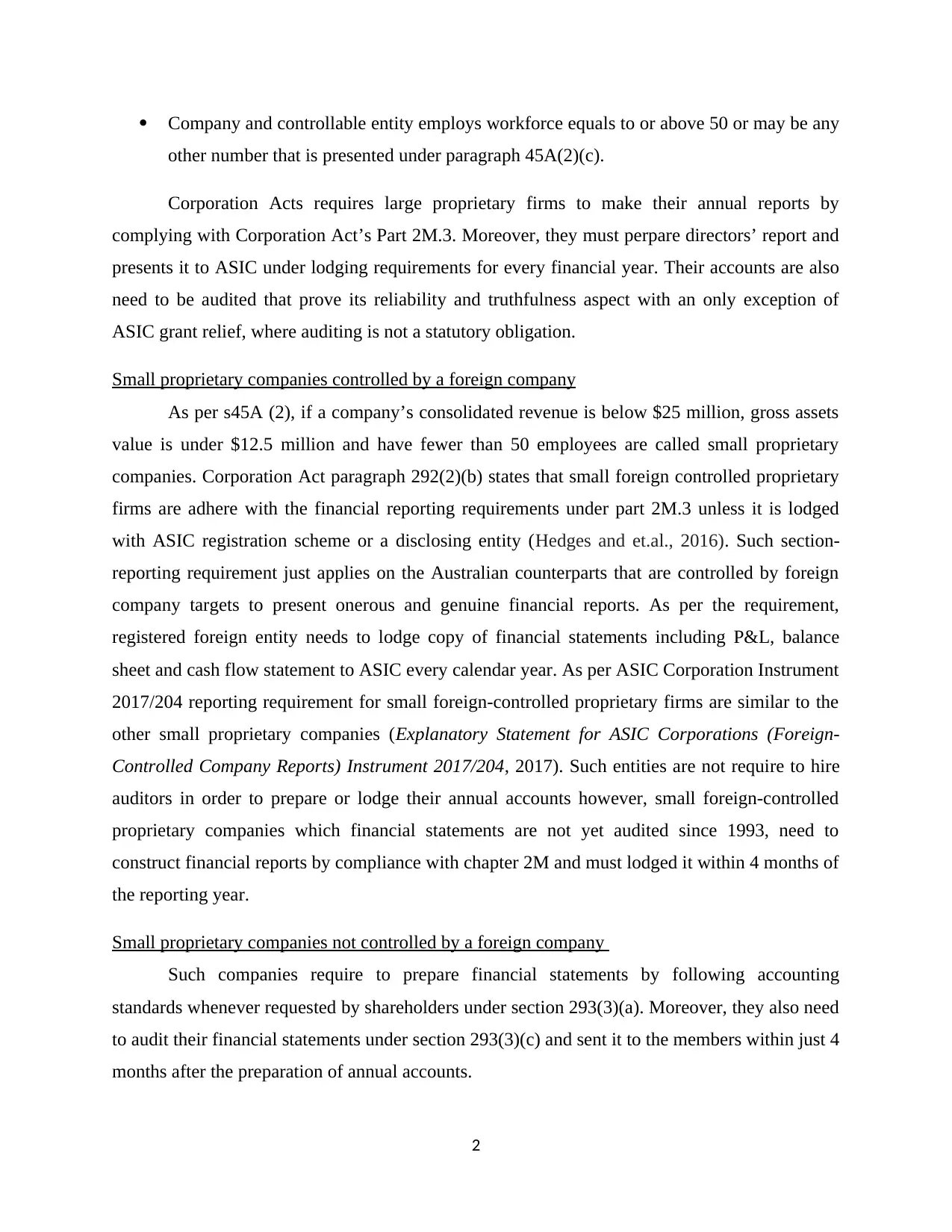
Company and controllable entity employs workforce equals to or above 50 or may be any
other number that is presented under paragraph 45A(2)(c).
Corporation Acts requires large proprietary firms to make their annual reports by
complying with Corporation Act’s Part 2M.3. Moreover, they must perpare directors’ report and
presents it to ASIC under lodging requirements for every financial year. Their accounts are also
need to be audited that prove its reliability and truthfulness aspect with an only exception of
ASIC grant relief, where auditing is not a statutory obligation.
Small proprietary companies controlled by a foreign company
As per s45A (2), if a company’s consolidated revenue is below $25 million, gross assets
value is under $12.5 million and have fewer than 50 employees are called small proprietary
companies. Corporation Act paragraph 292(2)(b) states that small foreign controlled proprietary
firms are adhere with the financial reporting requirements under part 2M.3 unless it is lodged
with ASIC registration scheme or a disclosing entity (Hedges and et.al., 2016). Such section-
reporting requirement just applies on the Australian counterparts that are controlled by foreign
company targets to present onerous and genuine financial reports. As per the requirement,
registered foreign entity needs to lodge copy of financial statements including P&L, balance
sheet and cash flow statement to ASIC every calendar year. As per ASIC Corporation Instrument
2017/204 reporting requirement for small foreign-controlled proprietary firms are similar to the
other small proprietary companies (Explanatory Statement for ASIC Corporations (Foreign-
Controlled Company Reports) Instrument 2017/204, 2017). Such entities are not require to hire
auditors in order to prepare or lodge their annual accounts however, small foreign-controlled
proprietary companies which financial statements are not yet audited since 1993, need to
construct financial reports by compliance with chapter 2M and must lodged it within 4 months of
the reporting year.
Small proprietary companies not controlled by a foreign company
Such companies require to prepare financial statements by following accounting
standards whenever requested by shareholders under section 293(3)(a). Moreover, they also need
to audit their financial statements under section 293(3)(c) and sent it to the members within just 4
months after the preparation of annual accounts.
2
other number that is presented under paragraph 45A(2)(c).
Corporation Acts requires large proprietary firms to make their annual reports by
complying with Corporation Act’s Part 2M.3. Moreover, they must perpare directors’ report and
presents it to ASIC under lodging requirements for every financial year. Their accounts are also
need to be audited that prove its reliability and truthfulness aspect with an only exception of
ASIC grant relief, where auditing is not a statutory obligation.
Small proprietary companies controlled by a foreign company
As per s45A (2), if a company’s consolidated revenue is below $25 million, gross assets
value is under $12.5 million and have fewer than 50 employees are called small proprietary
companies. Corporation Act paragraph 292(2)(b) states that small foreign controlled proprietary
firms are adhere with the financial reporting requirements under part 2M.3 unless it is lodged
with ASIC registration scheme or a disclosing entity (Hedges and et.al., 2016). Such section-
reporting requirement just applies on the Australian counterparts that are controlled by foreign
company targets to present onerous and genuine financial reports. As per the requirement,
registered foreign entity needs to lodge copy of financial statements including P&L, balance
sheet and cash flow statement to ASIC every calendar year. As per ASIC Corporation Instrument
2017/204 reporting requirement for small foreign-controlled proprietary firms are similar to the
other small proprietary companies (Explanatory Statement for ASIC Corporations (Foreign-
Controlled Company Reports) Instrument 2017/204, 2017). Such entities are not require to hire
auditors in order to prepare or lodge their annual accounts however, small foreign-controlled
proprietary companies which financial statements are not yet audited since 1993, need to
construct financial reports by compliance with chapter 2M and must lodged it within 4 months of
the reporting year.
Small proprietary companies not controlled by a foreign company
Such companies require to prepare financial statements by following accounting
standards whenever requested by shareholders under section 293(3)(a). Moreover, they also need
to audit their financial statements under section 293(3)(c) and sent it to the members within just 4
months after the preparation of annual accounts.
2
Paraphrase This Document
Need a fresh take? Get an instant paraphrase of this document with our AI Paraphraser
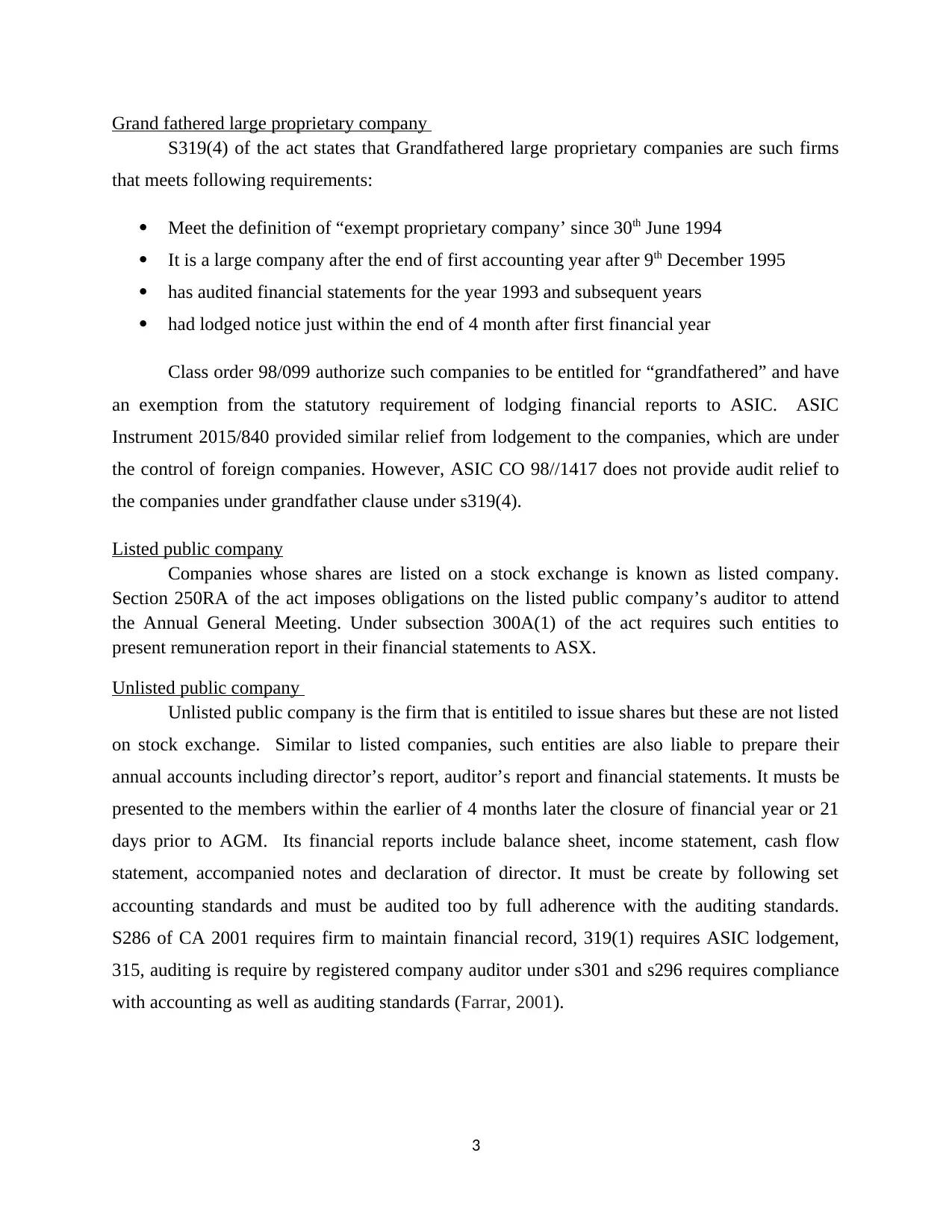
Grand fathered large proprietary company
S319(4) of the act states that Grandfathered large proprietary companies are such firms
that meets following requirements:
Meet the definition of “exempt proprietary company’ since 30th June 1994
It is a large company after the end of first accounting year after 9th December 1995
has audited financial statements for the year 1993 and subsequent years
had lodged notice just within the end of 4 month after first financial year
Class order 98/099 authorize such companies to be entitled for “grandfathered” and have
an exemption from the statutory requirement of lodging financial reports to ASIC. ASIC
Instrument 2015/840 provided similar relief from lodgement to the companies, which are under
the control of foreign companies. However, ASIC CO 98//1417 does not provide audit relief to
the companies under grandfather clause under s319(4).
Listed public company
Companies whose shares are listed on a stock exchange is known as listed company.
Section 250RA of the act imposes obligations on the listed public company’s auditor to attend
the Annual General Meeting. Under subsection 300A(1) of the act requires such entities to
present remuneration report in their financial statements to ASX.
Unlisted public company
Unlisted public company is the firm that is entitiled to issue shares but these are not listed
on stock exchange. Similar to listed companies, such entities are also liable to prepare their
annual accounts including director’s report, auditor’s report and financial statements. It musts be
presented to the members within the earlier of 4 months later the closure of financial year or 21
days prior to AGM. Its financial reports include balance sheet, income statement, cash flow
statement, accompanied notes and declaration of director. It must be create by following set
accounting standards and must be audited too by full adherence with the auditing standards.
S286 of CA 2001 requires firm to maintain financial record, 319(1) requires ASIC lodgement,
315, auditing is require by registered company auditor under s301 and s296 requires compliance
with accounting as well as auditing standards (Farrar, 2001).
3
S319(4) of the act states that Grandfathered large proprietary companies are such firms
that meets following requirements:
Meet the definition of “exempt proprietary company’ since 30th June 1994
It is a large company after the end of first accounting year after 9th December 1995
has audited financial statements for the year 1993 and subsequent years
had lodged notice just within the end of 4 month after first financial year
Class order 98/099 authorize such companies to be entitled for “grandfathered” and have
an exemption from the statutory requirement of lodging financial reports to ASIC. ASIC
Instrument 2015/840 provided similar relief from lodgement to the companies, which are under
the control of foreign companies. However, ASIC CO 98//1417 does not provide audit relief to
the companies under grandfather clause under s319(4).
Listed public company
Companies whose shares are listed on a stock exchange is known as listed company.
Section 250RA of the act imposes obligations on the listed public company’s auditor to attend
the Annual General Meeting. Under subsection 300A(1) of the act requires such entities to
present remuneration report in their financial statements to ASX.
Unlisted public company
Unlisted public company is the firm that is entitiled to issue shares but these are not listed
on stock exchange. Similar to listed companies, such entities are also liable to prepare their
annual accounts including director’s report, auditor’s report and financial statements. It musts be
presented to the members within the earlier of 4 months later the closure of financial year or 21
days prior to AGM. Its financial reports include balance sheet, income statement, cash flow
statement, accompanied notes and declaration of director. It must be create by following set
accounting standards and must be audited too by full adherence with the auditing standards.
S286 of CA 2001 requires firm to maintain financial record, 319(1) requires ASIC lodgement,
315, auditing is require by registered company auditor under s301 and s296 requires compliance
with accounting as well as auditing standards (Farrar, 2001).
3
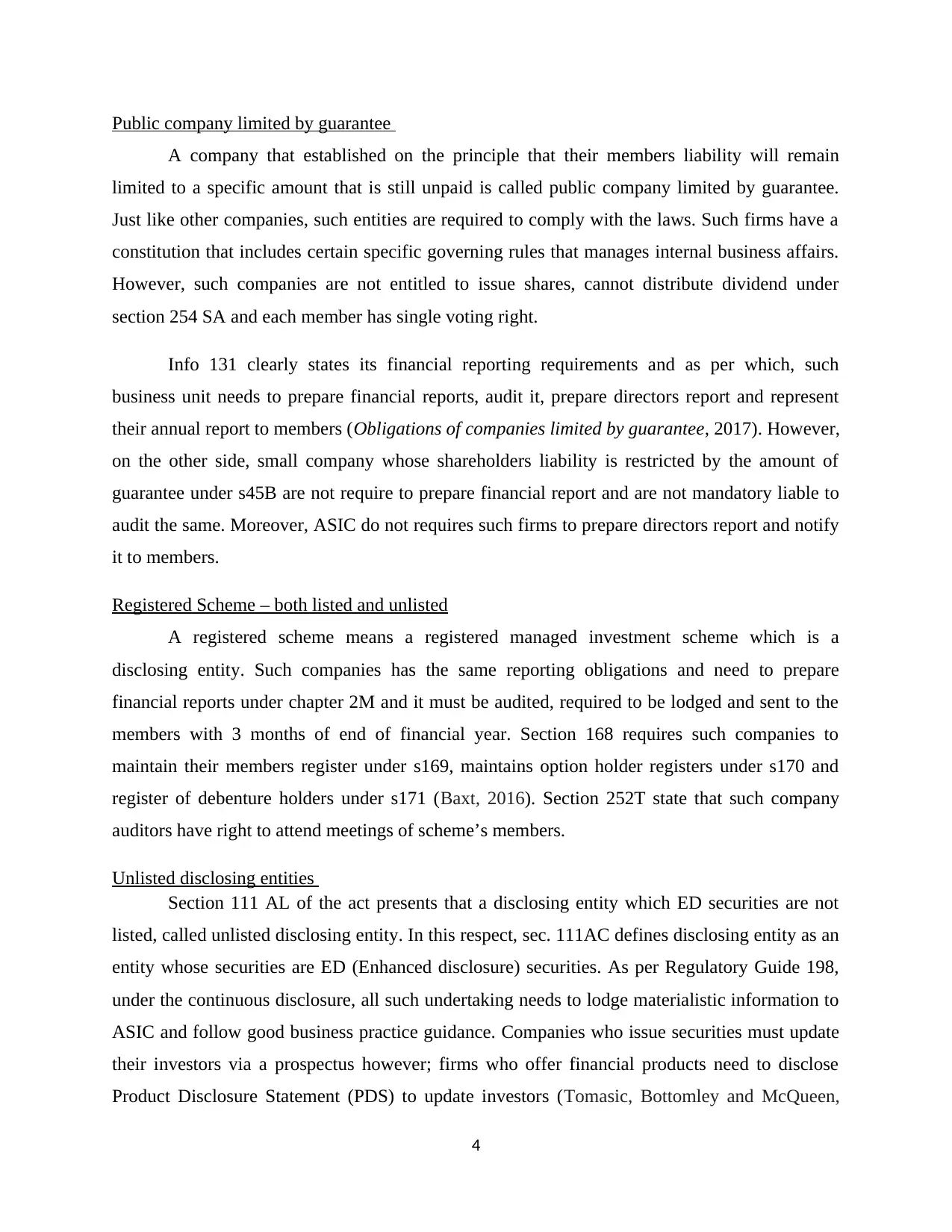
Public company limited by guarantee
A company that established on the principle that their members liability will remain
limited to a specific amount that is still unpaid is called public company limited by guarantee.
Just like other companies, such entities are required to comply with the laws. Such firms have a
constitution that includes certain specific governing rules that manages internal business affairs.
However, such companies are not entitled to issue shares, cannot distribute dividend under
section 254 SA and each member has single voting right.
Info 131 clearly states its financial reporting requirements and as per which, such
business unit needs to prepare financial reports, audit it, prepare directors report and represent
their annual report to members (Obligations of companies limited by guarantee, 2017). However,
on the other side, small company whose shareholders liability is restricted by the amount of
guarantee under s45B are not require to prepare financial report and are not mandatory liable to
audit the same. Moreover, ASIC do not requires such firms to prepare directors report and notify
it to members.
Registered Scheme – both listed and unlisted
A registered scheme means a registered managed investment scheme which is a
disclosing entity. Such companies has the same reporting obligations and need to prepare
financial reports under chapter 2M and it must be audited, required to be lodged and sent to the
members with 3 months of end of financial year. Section 168 requires such companies to
maintain their members register under s169, maintains option holder registers under s170 and
register of debenture holders under s171 (Baxt, 2016). Section 252T state that such company
auditors have right to attend meetings of scheme’s members.
Unlisted disclosing entities
Section 111 AL of the act presents that a disclosing entity which ED securities are not
listed, called unlisted disclosing entity. In this respect, sec. 111AC defines disclosing entity as an
entity whose securities are ED (Enhanced disclosure) securities. As per Regulatory Guide 198,
under the continuous disclosure, all such undertaking needs to lodge materialistic information to
ASIC and follow good business practice guidance. Companies who issue securities must update
their investors via a prospectus however; firms who offer financial products need to disclose
Product Disclosure Statement (PDS) to update investors (Tomasic, Bottomley and McQueen,
4
A company that established on the principle that their members liability will remain
limited to a specific amount that is still unpaid is called public company limited by guarantee.
Just like other companies, such entities are required to comply with the laws. Such firms have a
constitution that includes certain specific governing rules that manages internal business affairs.
However, such companies are not entitled to issue shares, cannot distribute dividend under
section 254 SA and each member has single voting right.
Info 131 clearly states its financial reporting requirements and as per which, such
business unit needs to prepare financial reports, audit it, prepare directors report and represent
their annual report to members (Obligations of companies limited by guarantee, 2017). However,
on the other side, small company whose shareholders liability is restricted by the amount of
guarantee under s45B are not require to prepare financial report and are not mandatory liable to
audit the same. Moreover, ASIC do not requires such firms to prepare directors report and notify
it to members.
Registered Scheme – both listed and unlisted
A registered scheme means a registered managed investment scheme which is a
disclosing entity. Such companies has the same reporting obligations and need to prepare
financial reports under chapter 2M and it must be audited, required to be lodged and sent to the
members with 3 months of end of financial year. Section 168 requires such companies to
maintain their members register under s169, maintains option holder registers under s170 and
register of debenture holders under s171 (Baxt, 2016). Section 252T state that such company
auditors have right to attend meetings of scheme’s members.
Unlisted disclosing entities
Section 111 AL of the act presents that a disclosing entity which ED securities are not
listed, called unlisted disclosing entity. In this respect, sec. 111AC defines disclosing entity as an
entity whose securities are ED (Enhanced disclosure) securities. As per Regulatory Guide 198,
under the continuous disclosure, all such undertaking needs to lodge materialistic information to
ASIC and follow good business practice guidance. Companies who issue securities must update
their investors via a prospectus however; firms who offer financial products need to disclose
Product Disclosure Statement (PDS) to update investors (Tomasic, Bottomley and McQueen,
4
⊘ This is a preview!⊘
Do you want full access?
Subscribe today to unlock all pages.

Trusted by 1+ million students worldwide
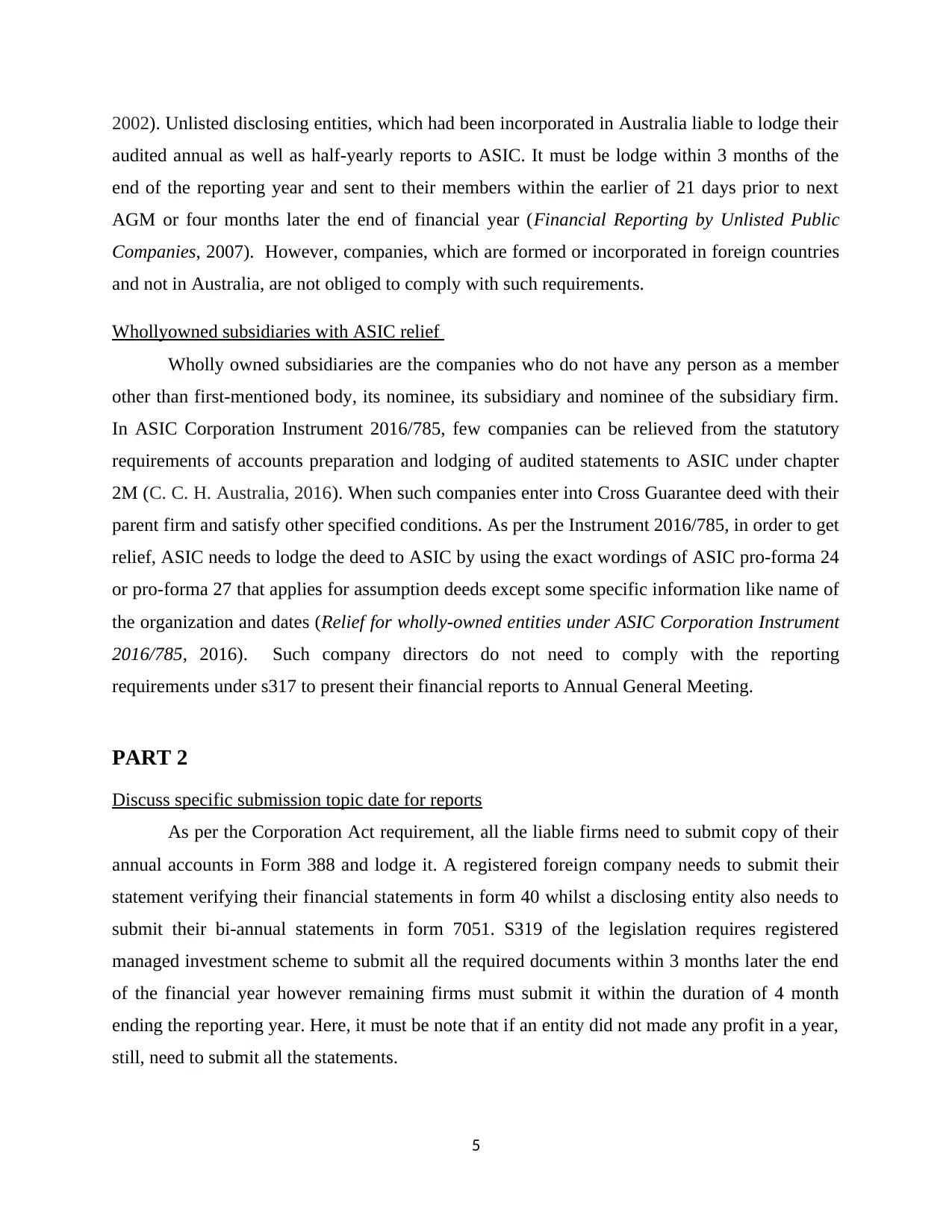
2002). Unlisted disclosing entities, which had been incorporated in Australia liable to lodge their
audited annual as well as half-yearly reports to ASIC. It must be lodge within 3 months of the
end of the reporting year and sent to their members within the earlier of 21 days prior to next
AGM or four months later the end of financial year (Financial Reporting by Unlisted Public
Companies, 2007). However, companies, which are formed or incorporated in foreign countries
and not in Australia, are not obliged to comply with such requirements.
Whollyowned subsidiaries with ASIC relief
Wholly owned subsidiaries are the companies who do not have any person as a member
other than first-mentioned body, its nominee, its subsidiary and nominee of the subsidiary firm.
In ASIC Corporation Instrument 2016/785, few companies can be relieved from the statutory
requirements of accounts preparation and lodging of audited statements to ASIC under chapter
2M (C. C. H. Australia, 2016). When such companies enter into Cross Guarantee deed with their
parent firm and satisfy other specified conditions. As per the Instrument 2016/785, in order to get
relief, ASIC needs to lodge the deed to ASIC by using the exact wordings of ASIC pro-forma 24
or pro-forma 27 that applies for assumption deeds except some specific information like name of
the organization and dates (Relief for wholly-owned entities under ASIC Corporation Instrument
2016/785, 2016). Such company directors do not need to comply with the reporting
requirements under s317 to present their financial reports to Annual General Meeting.
PART 2
Discuss specific submission topic date for reports
As per the Corporation Act requirement, all the liable firms need to submit copy of their
annual accounts in Form 388 and lodge it. A registered foreign company needs to submit their
statement verifying their financial statements in form 40 whilst a disclosing entity also needs to
submit their bi-annual statements in form 7051. S319 of the legislation requires registered
managed investment scheme to submit all the required documents within 3 months later the end
of the financial year however remaining firms must submit it within the duration of 4 month
ending the reporting year. Here, it must be note that if an entity did not made any profit in a year,
still, need to submit all the statements.
5
audited annual as well as half-yearly reports to ASIC. It must be lodge within 3 months of the
end of the reporting year and sent to their members within the earlier of 21 days prior to next
AGM or four months later the end of financial year (Financial Reporting by Unlisted Public
Companies, 2007). However, companies, which are formed or incorporated in foreign countries
and not in Australia, are not obliged to comply with such requirements.
Whollyowned subsidiaries with ASIC relief
Wholly owned subsidiaries are the companies who do not have any person as a member
other than first-mentioned body, its nominee, its subsidiary and nominee of the subsidiary firm.
In ASIC Corporation Instrument 2016/785, few companies can be relieved from the statutory
requirements of accounts preparation and lodging of audited statements to ASIC under chapter
2M (C. C. H. Australia, 2016). When such companies enter into Cross Guarantee deed with their
parent firm and satisfy other specified conditions. As per the Instrument 2016/785, in order to get
relief, ASIC needs to lodge the deed to ASIC by using the exact wordings of ASIC pro-forma 24
or pro-forma 27 that applies for assumption deeds except some specific information like name of
the organization and dates (Relief for wholly-owned entities under ASIC Corporation Instrument
2016/785, 2016). Such company directors do not need to comply with the reporting
requirements under s317 to present their financial reports to Annual General Meeting.
PART 2
Discuss specific submission topic date for reports
As per the Corporation Act requirement, all the liable firms need to submit copy of their
annual accounts in Form 388 and lodge it. A registered foreign company needs to submit their
statement verifying their financial statements in form 40 whilst a disclosing entity also needs to
submit their bi-annual statements in form 7051. S319 of the legislation requires registered
managed investment scheme to submit all the required documents within 3 months later the end
of the financial year however remaining firms must submit it within the duration of 4 month
ending the reporting year. Here, it must be note that if an entity did not made any profit in a year,
still, need to submit all the statements.
5
Paraphrase This Document
Need a fresh take? Get an instant paraphrase of this document with our AI Paraphraser
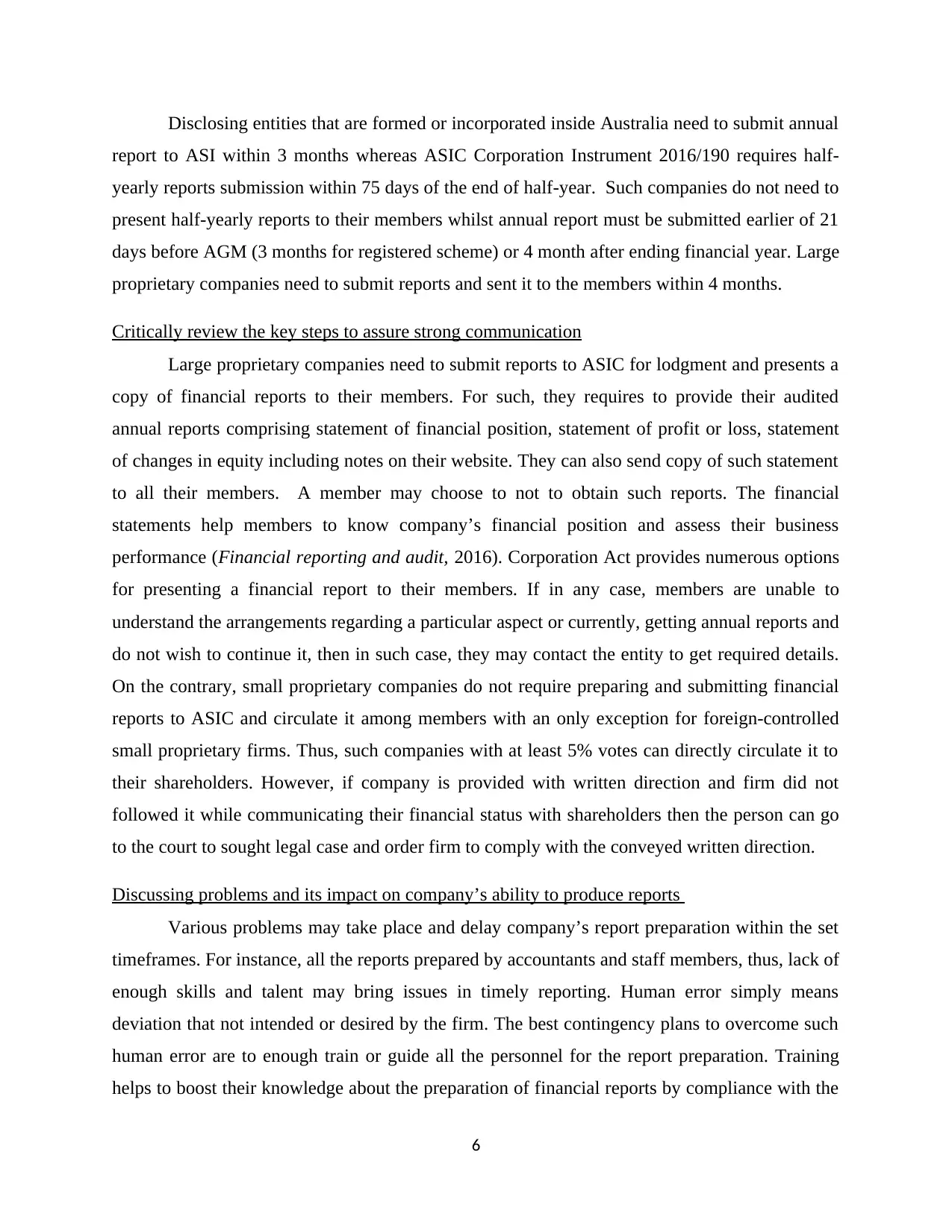
Disclosing entities that are formed or incorporated inside Australia need to submit annual
report to ASI within 3 months whereas ASIC Corporation Instrument 2016/190 requires half-
yearly reports submission within 75 days of the end of half-year. Such companies do not need to
present half-yearly reports to their members whilst annual report must be submitted earlier of 21
days before AGM (3 months for registered scheme) or 4 month after ending financial year. Large
proprietary companies need to submit reports and sent it to the members within 4 months.
Critically review the key steps to assure strong communication
Large proprietary companies need to submit reports to ASIC for lodgment and presents a
copy of financial reports to their members. For such, they requires to provide their audited
annual reports comprising statement of financial position, statement of profit or loss, statement
of changes in equity including notes on their website. They can also send copy of such statement
to all their members. A member may choose to not to obtain such reports. The financial
statements help members to know company’s financial position and assess their business
performance (Financial reporting and audit, 2016). Corporation Act provides numerous options
for presenting a financial report to their members. If in any case, members are unable to
understand the arrangements regarding a particular aspect or currently, getting annual reports and
do not wish to continue it, then in such case, they may contact the entity to get required details.
On the contrary, small proprietary companies do not require preparing and submitting financial
reports to ASIC and circulate it among members with an only exception for foreign-controlled
small proprietary firms. Thus, such companies with at least 5% votes can directly circulate it to
their shareholders. However, if company is provided with written direction and firm did not
followed it while communicating their financial status with shareholders then the person can go
to the court to sought legal case and order firm to comply with the conveyed written direction.
Discussing problems and its impact on company’s ability to produce reports
Various problems may take place and delay company’s report preparation within the set
timeframes. For instance, all the reports prepared by accountants and staff members, thus, lack of
enough skills and talent may bring issues in timely reporting. Human error simply means
deviation that not intended or desired by the firm. The best contingency plans to overcome such
human error are to enough train or guide all the personnel for the report preparation. Training
helps to boost their knowledge about the preparation of financial reports by compliance with the
6
report to ASI within 3 months whereas ASIC Corporation Instrument 2016/190 requires half-
yearly reports submission within 75 days of the end of half-year. Such companies do not need to
present half-yearly reports to their members whilst annual report must be submitted earlier of 21
days before AGM (3 months for registered scheme) or 4 month after ending financial year. Large
proprietary companies need to submit reports and sent it to the members within 4 months.
Critically review the key steps to assure strong communication
Large proprietary companies need to submit reports to ASIC for lodgment and presents a
copy of financial reports to their members. For such, they requires to provide their audited
annual reports comprising statement of financial position, statement of profit or loss, statement
of changes in equity including notes on their website. They can also send copy of such statement
to all their members. A member may choose to not to obtain such reports. The financial
statements help members to know company’s financial position and assess their business
performance (Financial reporting and audit, 2016). Corporation Act provides numerous options
for presenting a financial report to their members. If in any case, members are unable to
understand the arrangements regarding a particular aspect or currently, getting annual reports and
do not wish to continue it, then in such case, they may contact the entity to get required details.
On the contrary, small proprietary companies do not require preparing and submitting financial
reports to ASIC and circulate it among members with an only exception for foreign-controlled
small proprietary firms. Thus, such companies with at least 5% votes can directly circulate it to
their shareholders. However, if company is provided with written direction and firm did not
followed it while communicating their financial status with shareholders then the person can go
to the court to sought legal case and order firm to comply with the conveyed written direction.
Discussing problems and its impact on company’s ability to produce reports
Various problems may take place and delay company’s report preparation within the set
timeframes. For instance, all the reports prepared by accountants and staff members, thus, lack of
enough skills and talent may bring issues in timely reporting. Human error simply means
deviation that not intended or desired by the firm. The best contingency plans to overcome such
human error are to enough train or guide all the personnel for the report preparation. Training
helps to boost their knowledge about the preparation of financial reports by compliance with the
6
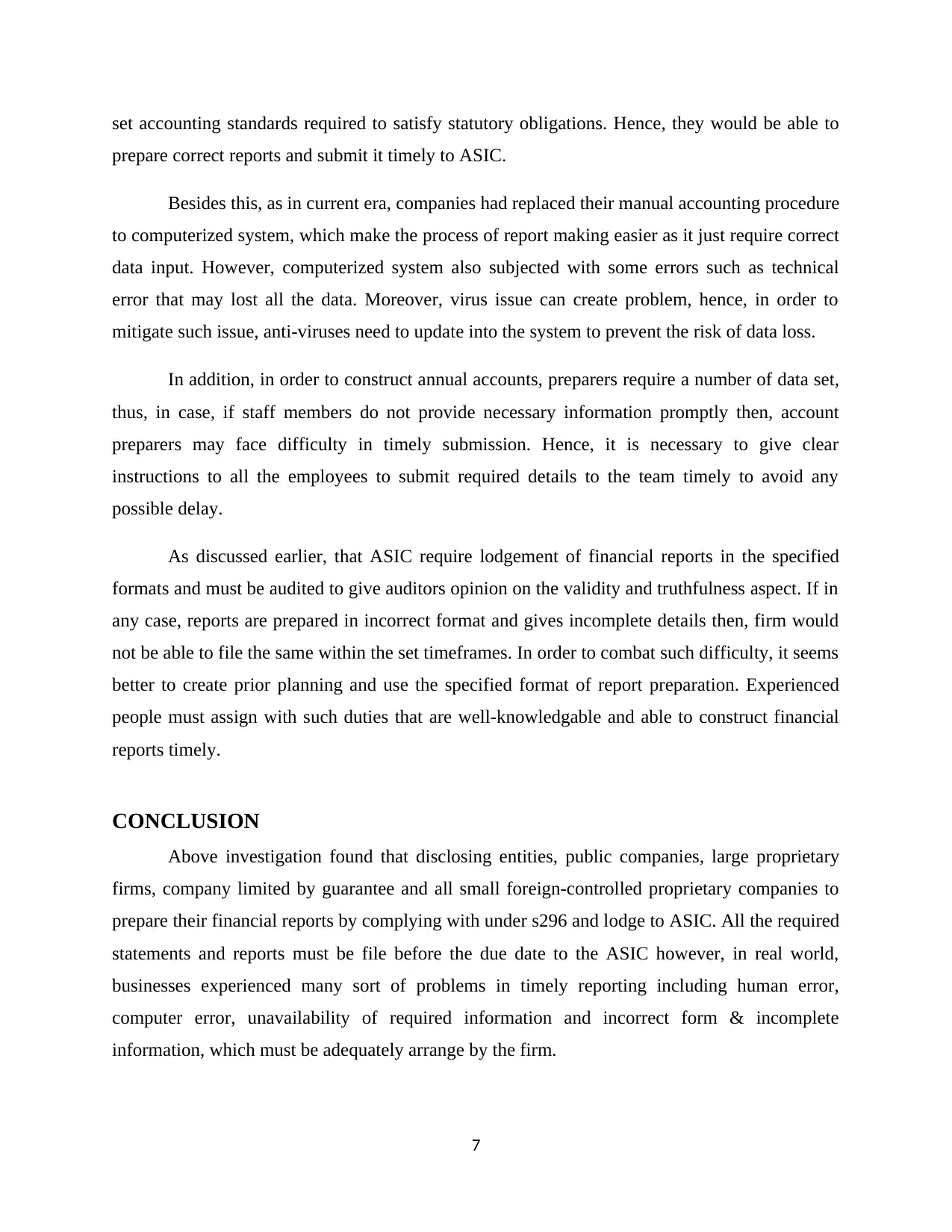
set accounting standards required to satisfy statutory obligations. Hence, they would be able to
prepare correct reports and submit it timely to ASIC.
Besides this, as in current era, companies had replaced their manual accounting procedure
to computerized system, which make the process of report making easier as it just require correct
data input. However, computerized system also subjected with some errors such as technical
error that may lost all the data. Moreover, virus issue can create problem, hence, in order to
mitigate such issue, anti-viruses need to update into the system to prevent the risk of data loss.
In addition, in order to construct annual accounts, preparers require a number of data set,
thus, in case, if staff members do not provide necessary information promptly then, account
preparers may face difficulty in timely submission. Hence, it is necessary to give clear
instructions to all the employees to submit required details to the team timely to avoid any
possible delay.
As discussed earlier, that ASIC require lodgement of financial reports in the specified
formats and must be audited to give auditors opinion on the validity and truthfulness aspect. If in
any case, reports are prepared in incorrect format and gives incomplete details then, firm would
not be able to file the same within the set timeframes. In order to combat such difficulty, it seems
better to create prior planning and use the specified format of report preparation. Experienced
people must assign with such duties that are well-knowledgable and able to construct financial
reports timely.
CONCLUSION
Above investigation found that disclosing entities, public companies, large proprietary
firms, company limited by guarantee and all small foreign-controlled proprietary companies to
prepare their financial reports by complying with under s296 and lodge to ASIC. All the required
statements and reports must be file before the due date to the ASIC however, in real world,
businesses experienced many sort of problems in timely reporting including human error,
computer error, unavailability of required information and incorrect form & incomplete
information, which must be adequately arrange by the firm.
7
prepare correct reports and submit it timely to ASIC.
Besides this, as in current era, companies had replaced their manual accounting procedure
to computerized system, which make the process of report making easier as it just require correct
data input. However, computerized system also subjected with some errors such as technical
error that may lost all the data. Moreover, virus issue can create problem, hence, in order to
mitigate such issue, anti-viruses need to update into the system to prevent the risk of data loss.
In addition, in order to construct annual accounts, preparers require a number of data set,
thus, in case, if staff members do not provide necessary information promptly then, account
preparers may face difficulty in timely submission. Hence, it is necessary to give clear
instructions to all the employees to submit required details to the team timely to avoid any
possible delay.
As discussed earlier, that ASIC require lodgement of financial reports in the specified
formats and must be audited to give auditors opinion on the validity and truthfulness aspect. If in
any case, reports are prepared in incorrect format and gives incomplete details then, firm would
not be able to file the same within the set timeframes. In order to combat such difficulty, it seems
better to create prior planning and use the specified format of report preparation. Experienced
people must assign with such duties that are well-knowledgable and able to construct financial
reports timely.
CONCLUSION
Above investigation found that disclosing entities, public companies, large proprietary
firms, company limited by guarantee and all small foreign-controlled proprietary companies to
prepare their financial reports by complying with under s296 and lodge to ASIC. All the required
statements and reports must be file before the due date to the ASIC however, in real world,
businesses experienced many sort of problems in timely reporting including human error,
computer error, unavailability of required information and incorrect form & incomplete
information, which must be adequately arrange by the firm.
7
⊘ This is a preview!⊘
Do you want full access?
Subscribe today to unlock all pages.

Trusted by 1+ million students worldwide
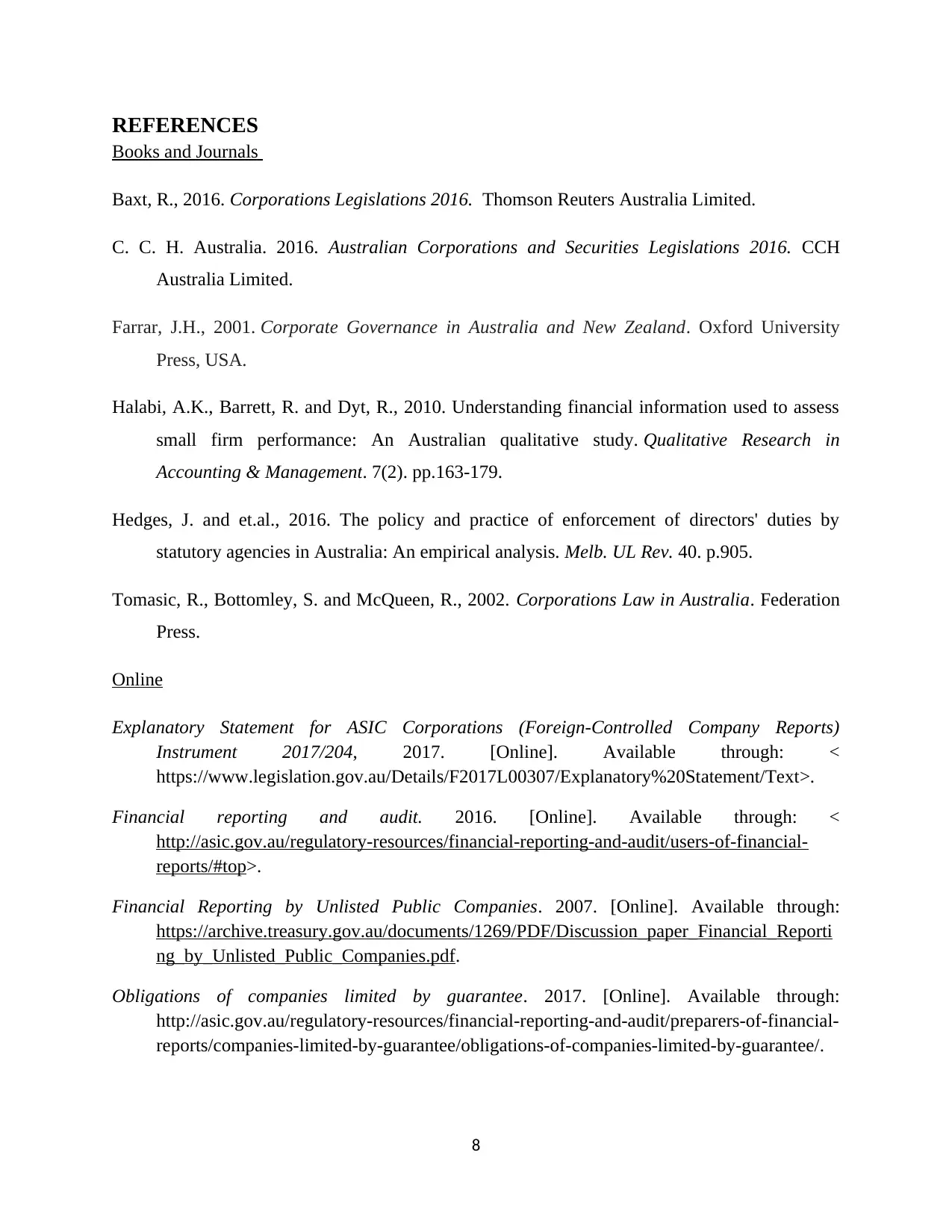
REFERENCES
Books and Journals
Baxt, R., 2016. Corporations Legislations 2016. Thomson Reuters Australia Limited.
C. C. H. Australia. 2016. Australian Corporations and Securities Legislations 2016. CCH
Australia Limited.
Farrar, J.H., 2001. Corporate Governance in Australia and New Zealand. Oxford University
Press, USA.
Halabi, A.K., Barrett, R. and Dyt, R., 2010. Understanding financial information used to assess
small firm performance: An Australian qualitative study. Qualitative Research in
Accounting & Management. 7(2). pp.163-179.
Hedges, J. and et.al., 2016. The policy and practice of enforcement of directors' duties by
statutory agencies in Australia: An empirical analysis. Melb. UL Rev. 40. p.905.
Tomasic, R., Bottomley, S. and McQueen, R., 2002. Corporations Law in Australia. Federation
Press.
Online
Explanatory Statement for ASIC Corporations (Foreign-Controlled Company Reports)
Instrument 2017/204, 2017. [Online]. Available through: <
https://www.legislation.gov.au/Details/F2017L00307/Explanatory%20Statement/Text>.
Financial reporting and audit. 2016. [Online]. Available through: <
http://asic.gov.au/regulatory-resources/financial-reporting-and-audit/users-of-financial-
reports/#top>.
Financial Reporting by Unlisted Public Companies. 2007. [Online]. Available through:
https://archive.treasury.gov.au/documents/1269/PDF/Discussion_paper_Financial_Reporti
ng_by_Unlisted_Public_Companies.pdf.
Obligations of companies limited by guarantee. 2017. [Online]. Available through:
http://asic.gov.au/regulatory-resources/financial-reporting-and-audit/preparers-of-financial-
reports/companies-limited-by-guarantee/obligations-of-companies-limited-by-guarantee/.
8
Books and Journals
Baxt, R., 2016. Corporations Legislations 2016. Thomson Reuters Australia Limited.
C. C. H. Australia. 2016. Australian Corporations and Securities Legislations 2016. CCH
Australia Limited.
Farrar, J.H., 2001. Corporate Governance in Australia and New Zealand. Oxford University
Press, USA.
Halabi, A.K., Barrett, R. and Dyt, R., 2010. Understanding financial information used to assess
small firm performance: An Australian qualitative study. Qualitative Research in
Accounting & Management. 7(2). pp.163-179.
Hedges, J. and et.al., 2016. The policy and practice of enforcement of directors' duties by
statutory agencies in Australia: An empirical analysis. Melb. UL Rev. 40. p.905.
Tomasic, R., Bottomley, S. and McQueen, R., 2002. Corporations Law in Australia. Federation
Press.
Online
Explanatory Statement for ASIC Corporations (Foreign-Controlled Company Reports)
Instrument 2017/204, 2017. [Online]. Available through: <
https://www.legislation.gov.au/Details/F2017L00307/Explanatory%20Statement/Text>.
Financial reporting and audit. 2016. [Online]. Available through: <
http://asic.gov.au/regulatory-resources/financial-reporting-and-audit/users-of-financial-
reports/#top>.
Financial Reporting by Unlisted Public Companies. 2007. [Online]. Available through:
https://archive.treasury.gov.au/documents/1269/PDF/Discussion_paper_Financial_Reporti
ng_by_Unlisted_Public_Companies.pdf.
Obligations of companies limited by guarantee. 2017. [Online]. Available through:
http://asic.gov.au/regulatory-resources/financial-reporting-and-audit/preparers-of-financial-
reports/companies-limited-by-guarantee/obligations-of-companies-limited-by-guarantee/.
8
Paraphrase This Document
Need a fresh take? Get an instant paraphrase of this document with our AI Paraphraser
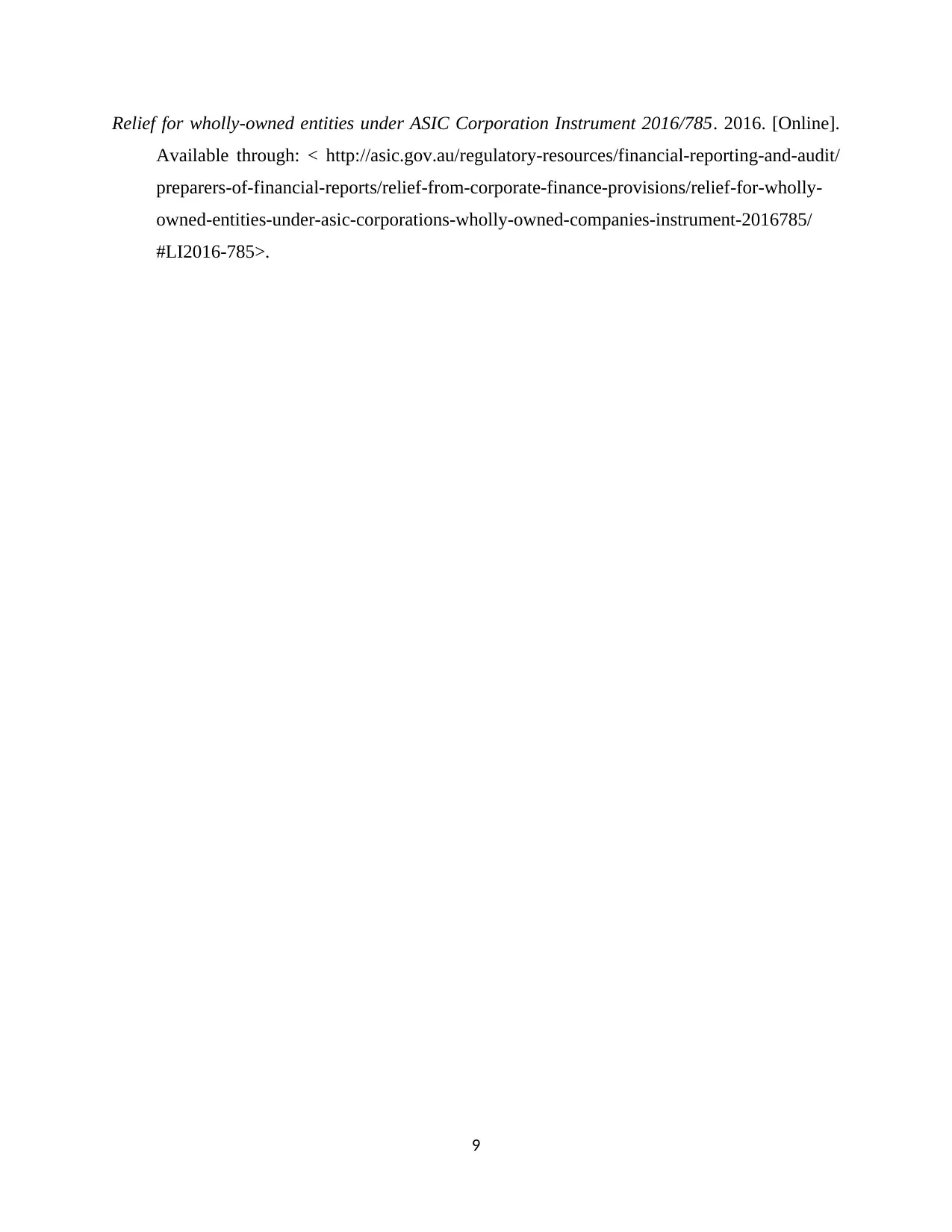
Relief for wholly-owned entities under ASIC Corporation Instrument 2016/785. 2016. [Online].
Available through: < http://asic.gov.au/regulatory-resources/financial-reporting-and-audit/
preparers-of-financial-reports/relief-from-corporate-finance-provisions/relief-for-wholly-
owned-entities-under-asic-corporations-wholly-owned-companies-instrument-2016785/
#LI2016-785>.
9
Available through: < http://asic.gov.au/regulatory-resources/financial-reporting-and-audit/
preparers-of-financial-reports/relief-from-corporate-finance-provisions/relief-for-wholly-
owned-entities-under-asic-corporations-wholly-owned-companies-instrument-2016785/
#LI2016-785>.
9
1 out of 11
Related Documents
Your All-in-One AI-Powered Toolkit for Academic Success.
+13062052269
info@desklib.com
Available 24*7 on WhatsApp / Email
![[object Object]](/_next/static/media/star-bottom.7253800d.svg)
Unlock your academic potential
Copyright © 2020–2025 A2Z Services. All Rights Reserved. Developed and managed by ZUCOL.




